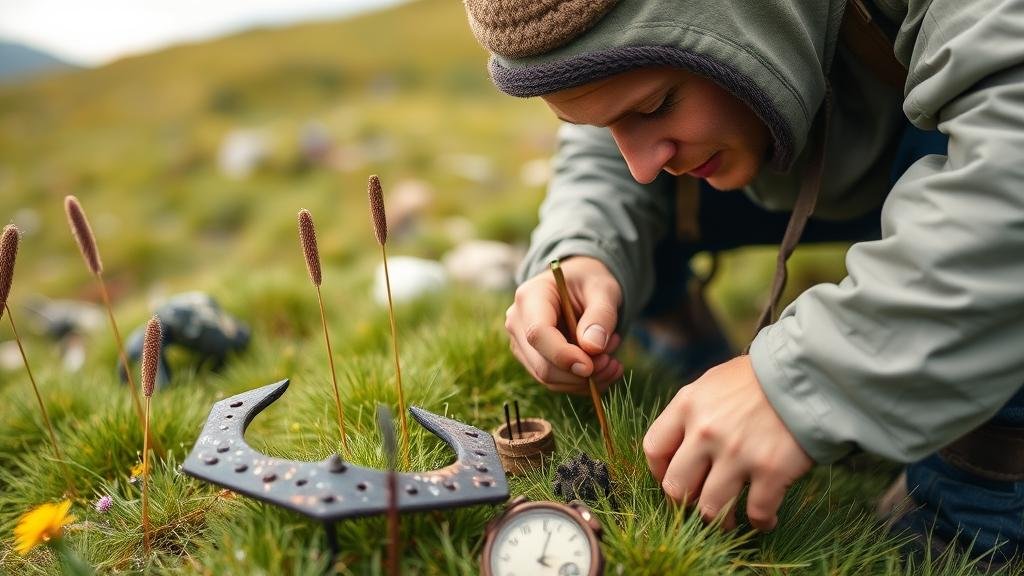Detecting in Undisturbed Alpine Meadows for Ancient Hunting Gear
Detecting in Undisturbed Alpine Meadows for Ancient Hunting Gear
The practice of detecting for ancient hunting gear in undisturbed alpine meadows is an intriguing intersection of archaeology, anthropology, and environmental science. These areas, often characterized by their cold climate and high altitude, preserve important historical artifacts that tell the story of ancient human interactions with nature. This article explores the methods, significance, challenges, and examples of this specialized field of study.
The Importance of Alpine Meadows
Alpine meadows are unique ecosystems characterized by their high-altitude, open landscapes, and diverse flora and fauna. e regions were often frequented by ancient hunter-gatherers, serving as sites for hunting and gathering, seasonal habitation, and social activities. The preservation of organic materials such as bones, tools, and other artifacts in these relatively undisturbed environments provides invaluable insight into prehistoric life.
Methods of Detection
Detecting ancient artifacts in alpine meadows involves a combination of traditional archaeological methods and modern technology. The most notable techniques include:
- Metal Detection: Metal detectors are commonly used to locate metallic remnants such as tools or weaponry. effectiveness of these devices is often determined by the mineralization of the soil and the object’s depth.
- Remote Sensing: Technologies like ground-penetrating radar (GPR) and aerial drone surveys help locate buried artifacts without intrusive digging.
- Soil Analysis: Analyzing soil samples can provide information about previous human activity, revealing concentrations of nutrients or alteration of the soil structure.
- GPS Mapping: Geographic Information Systems (GIS) are utilized to document artifact locations systematically, enabling researchers to create comprehensive maps that indicate patterns of human movement and settlement.
Case Studies and Real-World Applications
Several notable projects have successfully employed these techniques, yielding significant archaeological discoveries. One such project was conducted in the Rocky Mountain National Park, where researchers used remote sensing and metal detection to uncover ancient hunting stations used by Paleo-Indians. The excavation revealed projectile points, cut bones, and tools essential for understanding the subsistence strategies employed during that era.
Another successful case involved the investigation of alpine meadows in the Swiss Alps. Researchers discovered an exceptional collection of stone tools dating back over 6,000 years. The artifacts were remarkably well-preserved, and their analysis provided insights into the hunting practices and social organization of the people who inhabited the region.
Challenges and Considerations
While the potential rewards of detecting in alpine meadows are profound, numerous challenges must be addressed. These include:
- Environmental Impact: Disturbing the delicate alpine ecosystem can lead to erosion and damage to native plant species, necessitating careful planning and mitigation strategies.
- Legal and Ethical Concerns: Archaeological finds are often governed by laws that protect cultural heritage. It is crucial for researchers to follow legal protocols regarding artifact collection and reporting.
- Weather Conditions: The alpine environment poses challenges regarding access and safety. Researchers often must contend with rapid weather changes that can hinder fieldwork.
Actionable Takeaways
For those interested in engaging in the detection of ancient hunting gear in alpine meadows, consider the following steps:
- Familiarize Yourself with Local Regulations: Understanding legal frameworks regarding archaeological activities is crucial to ensure compliance and ethical practice.
- Conduct Thorough Research: Prior to fieldwork, study the ecology and history of the target area to maximize the chances of finding significant artifacts.
- Use Appropriate Technology: Investing in reliable detection tools, such as metal detectors and GPR, can greatly enhance the efficiency of archaeological surveys.
- Collaborate with Experts: Partnering with archaeologists and ecologists can improve the scientific rigor of your findings and ensure the preservation of the site.
To wrap up, detecting ancient hunting gear in undisturbed alpine meadows is a rich field that can vastly contribute to our understanding of prehistoric human culture and environmental interactions. By employing advanced techniques and adhering to ethical practices, researchers can continue to uncover the secrets these pristine ecosystems hold.


